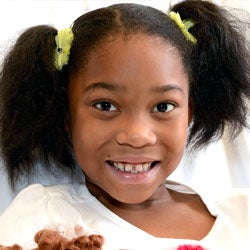Sickle Cell Disease
Mechia and Matthew Nickerson of Auburn, AL, are on a mission. They even have a tagline they use frequently in their conversation and on T-shirts: “Peace, Love, Cure—Hannah Grace.” Their 8-year-old daughter, Hannah, was diagnosed with Sickle Cell Disease (SCD) when she was 5 days old. SCD, an inherited blood disorder that affects red blood cells, is the number one cause of stroke and brain injury in childhood. Each year, 50-75 Alabama children are born with the disease. “I knew I had the sickle cell trait, but we did not know Matthew also carried it until after Hannah was diagnosed,” says Mechia. When both parents have sickle cell trait, they have a 25% chance with each pregnancy of having a baby with SCD. It has not been easy for the Nickersons to watch the progression of Hannah’s disease. She started taking daily doses of penicillin at age 4 weeks to try to minimize the swelling in her hands and feet. For the first two years of her life, she had to be hospitalized one or more times a month for a sickle cell crises—painful episodes that occur when sickle-shaped red blood cells block blood vessels and prevent blood and oxygen from reaching tissues. Then, when she was just 3 years old and had been in pain for two days, Hannah suffered a transient ischemic attack (TIA)—a “mini-stroke” that left her temporarily unable to move her knee. A few years later, there was a second TIA. This time the Nickersons received word from Hannah’s school that a teacher had found her unresponsive. Although the second attack was scary, there actually was a silver lining. “Hannah was no longer responding to medication, so we needed to take a different approach to managing her SCD,” Mechia explains. “That’s when she started seeing Dr. Tom Howard and his team at the Alabama Center for Childhood Cancer and Blood Disorders at Children’s of Alabama in Birmingham.” At first, Hannah responded well to monthly blood transfusions, but two years ago it was determined that red blood cell pheresis, a specialized transfusion technique available at only a small number of centers nationwide, was a better option for her. “Dr. Howard took the time to explain exactly what would happen in pheresis before Hannah began her treatment,” Matthew says. “He introduced us to another family whose child was undergoing pheresis, and that helped a lot. We have asked Dr. Howard to delay retiring until after Hannah is grown! He is a wonderful man!” There’s another reason Mechia and Matthew are happy Hannah is a patient at Children’s: The fact that Children’s is home to the state’s only dedicated pediatric bone marrow transplant (BMT) program. BMT is the only treatment that can potentially cure SCD—and the Nickersons learned in April that there are two potential donors who are matches for Hannah. They say this good news further boosts their dedication to educating the public about Sickle Cell Disease. “We are involved in a number of programs like Sickle Cell walks and World Sickle Cell Day, and we also try to get the word out through social media and speaking at local churches,” Mechia says. “We want Alabamians to know the facts about SCD, and we also want to advocate for a cure for every child who suffers from this disease.” Hannah’s story already has been a great inspiration to her cousin, Ariel Williams, who is studying nursing at UAB. “Ariel chose to attend UAB because of the opportunity to work and volunteer at Children's,” Mechia says. “She hopes to be accepted to medical school, where she plans to specialize in hematology/oncology—and join the fight to help find a cure for SCD. “Hannah says she wants to be a nurse, too, when she grows up,” she adds. “Our dream is that our daughter is able to live and to fulfill her dreams.”







